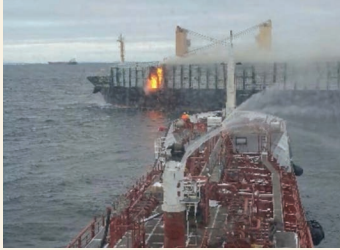The Nautical Institute presents an incident where, a general cargo vessel was fully loaded with cut timber packed into plastic-wrapped packages, both in the cargo hold and on deck.
The incident
As the vessel was departing its loading berth, the linesman noticed that an electrical extension cord between the vessel and the quay had not been disconnected. The crew on the forecastle informed the bridge team, but the vessel was already moving away from the berth, and it was not possible to prevent the cable from breaking.
When the pilot left the vessel, he saw a few metres of the extension cable hanging down by the side of the vessel. The cable was not inspected after the vessel departed. During the voyage there were no observed anomalies.
The vessel anchored in a port to bunker via a bunkering barge. Just after the bunkering began, the crew of the bunkering barge smelt smoke. Then they saw flames emerging from the deck cargo of the general cargo vessel on the port side, forward.
They immediately informed the crew of the vessel and bunkering was stopped. The bunkering barge cast off and moved away. The crew on the barge then activated their water cannon and moved closer to the general cargo vessel in order to attempt to extinguish the fire. Meanwhile, the crew on the vessel were also attempting to extinguish the fire using the vessel’s own firefighting equipment. Other tugs and small boats arrived to help extinguish the fire, but all efforts were in vain.
Under her own power and with tugboats attached, the general cargo vessel was docked at a port of refuge seven days after the fire had first been detected. Finally, three days after the vessel had docked and fully 10 days after the fire was first detected, the fire was declared extinguished.
The official investigation found, among other things, that the extension cable that broke while undocking was probably live when the fire started. Although a circuit breaker normally trips rapidly if there is a direct metallic connection between two conductors, if the current is passing through an electric arc and electrical conductors with substantial impedance (electrical resistance), the current may be too low to trip the circuit breaker. So, in all probability, an electric arc had come into contact with the plastic packaging or the wood and eventually ignited the material.

Lessons learned
- Any situation where potentially ‘live’ circuits or wires are exposed should be corrected with the briefest of delays.
- The management of this vessel fire was one of the most extensive operations of its kind in modern times for Sweden. Among other things, the investigation revealed that multiple and overlapping responsible agencies needed to cooperate, but no protocols had been established prior to the emergency
- The management of ships in need of assistance must be robust. Prior planning for all contingencies should be undertaken by a wide swath of concerned agencies including at the local, municipal and federal levels






























































